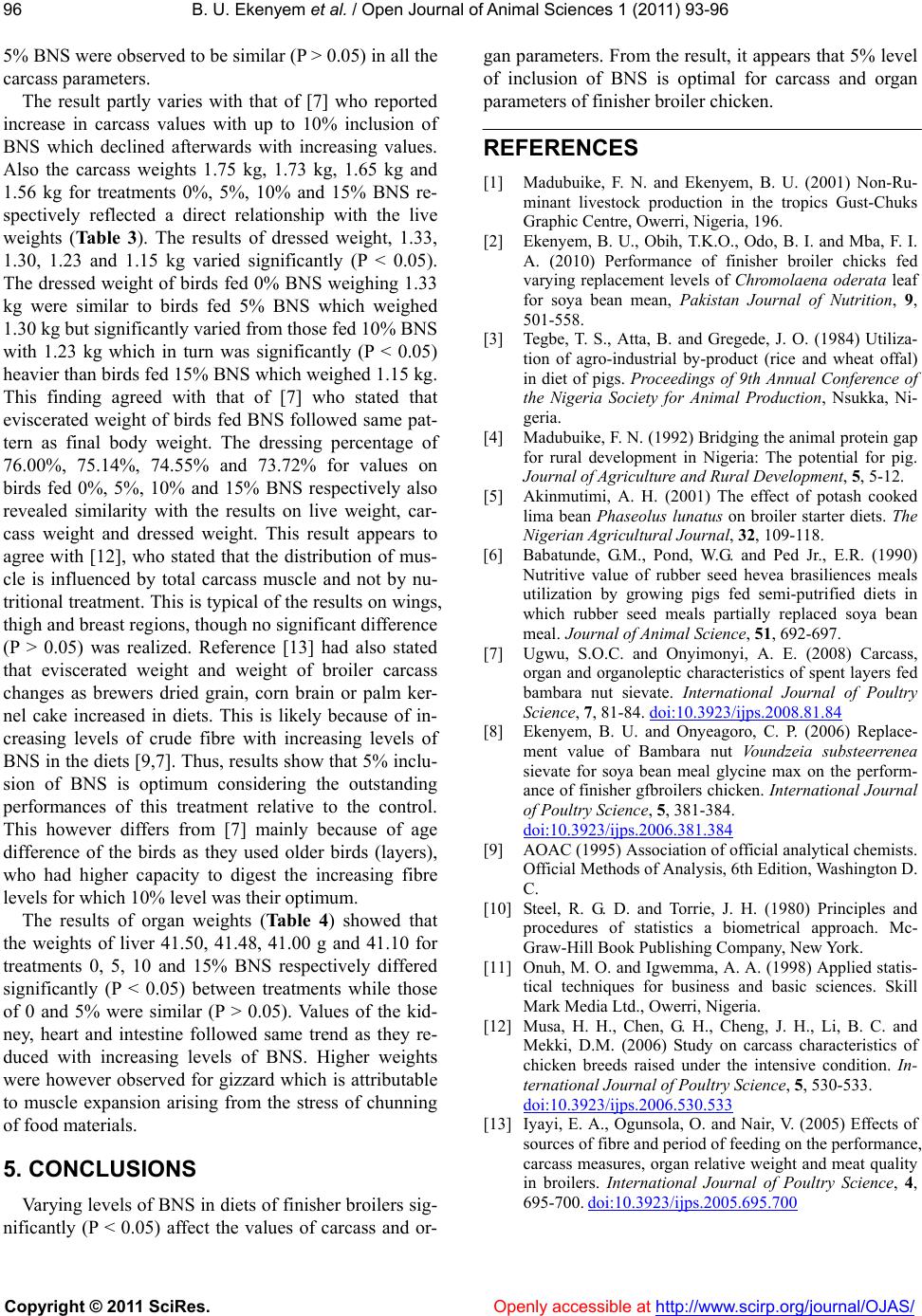
B. U. Ekenyem et al. / Open Journal of Anim al Sciences 1 (2011) 93-96
Copyright © 2011 SciRes. Openly accessible at http://www.scirp.org/journal/OJAS/
96
5% BNS were observed to be similar (P > 0.05) in all the
carcass parameters.
The result partly varies with that of [7] who reported
increase in carcass values with up to 10% inclusion of
BNS which declined afterwards with increasing values.
Also the carcass weights 1.75 kg, 1.73 kg, 1.65 kg and
1.56 kg for treatments 0%, 5%, 10% and 15% BNS re-
spectively reflected a direct relationship with the live
weights (Table 3). The results of dressed weight, 1.33,
1.30, 1.23 and 1.15 kg varied significantly (P < 0.05).
The dressed weight of birds fed 0% BNS weighing 1.33
kg were similar to birds fed 5% BNS which weighed
1.30 kg but significantly varied from those fed 10% BNS
with 1.23 kg which in turn was significantly (P < 0.05)
heavier than bird s fed 15% BNS which weig hed 1.15 kg.
This finding agreed with that of [7] who stated that
eviscerated weight of birds fed BNS followed same pat-
tern as final body weight. The dressing percentage of
76.00%, 75.14%, 74.55% and 73.72% for values on
birds fed 0%, 5%, 10% and 15% BNS respectively also
revealed similarity with the results on live weight, car-
cass weight and dressed weight. This result appears to
agree with [12], who stated that the distribution of mus-
cle is influenced by total carcass muscle and not by nu-
tritional treatment. This is typical o f the results on wings,
thigh and breast r egion s, thoug h no sign if ican t difference
(P > 0.05) was realized. Reference [13] had also stated
that eviscerated weight and weight of broiler carcass
changes as brewers dried grain, corn brain or palm ker-
nel cake increased in diets. This is likely because of in-
creasing levels of crude fibre with increasing levels of
BNS in the diets [9,7]. Thus, results sh ow that 5% inclu-
sion of BNS is optimum considering the outstanding
performances of this treatment relative to the control.
This however differs from [7] mainly because of age
difference of the birds as they used older birds (layers),
who had higher capacity to digest the increasing fibre
levels for which 10% leve l was their optimum.
The results of organ weights (Table 4) showed that
the weights of liver 41.50, 41.48, 41.00 g and 41.10 for
treatments 0, 5, 10 and 15% BNS respectively differed
significantly (P < 0.05) between treatments while those
of 0 and 5% were similar (P > 0.05). Values of the kid-
ney, heart and intestine followed same trend as they re-
duced with increasing levels of BNS. Higher weights
were however observed for gizzard which is attributable
to muscle expansion arising from the stress of chunning
of food materials.
5. CONCLUSIONS
Varying levels of BNS in diets of finisher broilers sig-
nificantly (P < 0.05) affect the values of carcass and or-
gan parameters. From the result, it appears that 5% level
of inclusion of BNS is optimal for carcass and organ
parameters of finisher broiler chicken.
REFERENCES
[1] Madubuike, F. N. and Ekenyem, B. U. (2001) Non-Ru-
minant livestock production in the tropics Gust-Chuks
Graphic Centre, Owerri, Nigeria, 196.
[2] Ekenyem, B. U., Obih, T.K.O., Odo, B. I. and Mba, F. I.
A. (2010) Performance of finisher broiler chicks fed
varying replacement levels of Chromolaena oderata leaf
for soya bean mean, Pakistan Journal of Nutrition, 9,
501-558.
[3] Tegbe, T. S., Atta, B. and Gregede, J. O. (1984) Utiliza-
tion of agro-industrial by-product (rice and wheat offal)
in diet of pigs. Proceedings of 9th Annual Conference of
the Nigeria Society for Animal Production, Nsukka, Ni-
geria.
[4] Madubuike, F. N. (1992) Bridging the animal protein gap
for rural development in Nigeria: The potential for pig.
Journal of Agriculture and Rural Development, 5, 5-12.
[5] Akinmutimi, A. H. (2001) The effect of potash cooked
lima bean Phaseolus lunatus on broiler starter diets. The
Nigerian Agricu ltural Journal , 32, 109-118.
[6] Babatunde, G.M., Pond, W.G. and Ped Jr., E.R. (1990)
Nutritive value of rubber seed hevea brasiliences meals
utilization by growing pigs fed semi-putrified diets in
which rubber seed meals partially replaced soya bean
meal. Journal of Animal Science, 51, 692-697.
[7] Ugwu, S.O.C. and Onyimonyi, A. E. (2008) Carcass,
organ and organoleptic characteristics of spent layers fed
bambara nut sievate. International Journal of Poultry
Science, 7, 81-84. doi:10.3923/ijps.2008.81.84
[8] Ekenyem, B. U. and Onyeagoro, C. P. (2006) Replace-
ment value of Bambara nut Voundzeia substeerrenea
sievate for soya bean meal glycine max on the perform-
ance of finisher gfbroilers chicken. International Journal
of Po ultry Science, 5, 381-384.
doi:10.3923/ijps.2006.381.384
[9] AOAC (1995) Association of official analytical chemists.
Official Methods of Analysis, 6th Edition, Washington D.
C.
[10] Steel, R. G. D. and Torrie, J. H. (1980) Principles and
procedures of statistics a biometrical approach. Mc-
Graw-Hill Book Publishing Company, New York.
[11] Onuh, M. O. and Igwemma, A. A. (1998) Applied statis-
tical techniques for business and basic sciences. Skill
Mark Media Ltd., Owerri, Nigeria.
[12] Musa, H. H., Chen, G. H., Cheng, J. H., Li, B. C. and
Mekki, D.M. (2006) Study on carcass characteristics of
chicken breeds raised under the intensive condition. In-
ternational Journal of Poultry Science, 5, 530-533.
doi:10.3923/ijps.2006.530.533
[13] Iyayi, E. A., Ogunsola, O. and Nair, V. (2005) Effects of
sources of fibre and period of feeding on the performance,
carcass measures, organ relative weight and meat quality
in broilers. International Journal of Poultry Science, 4,
695-700. doi:10.3923/ijps.2005.695.700